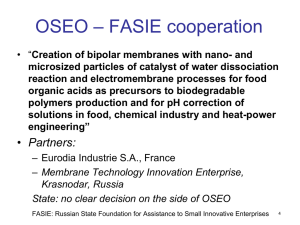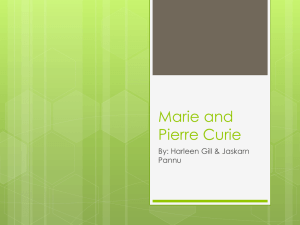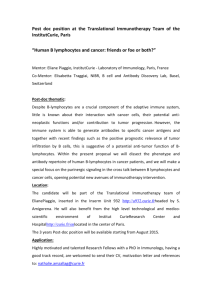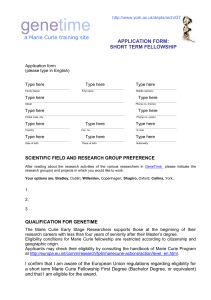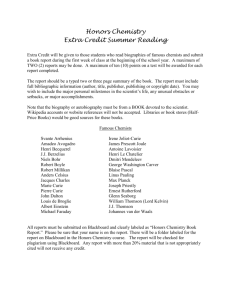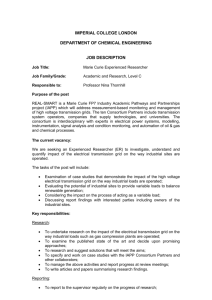Trial 1 – Water Bath - Department of Physics and Engineering Physics
advertisement
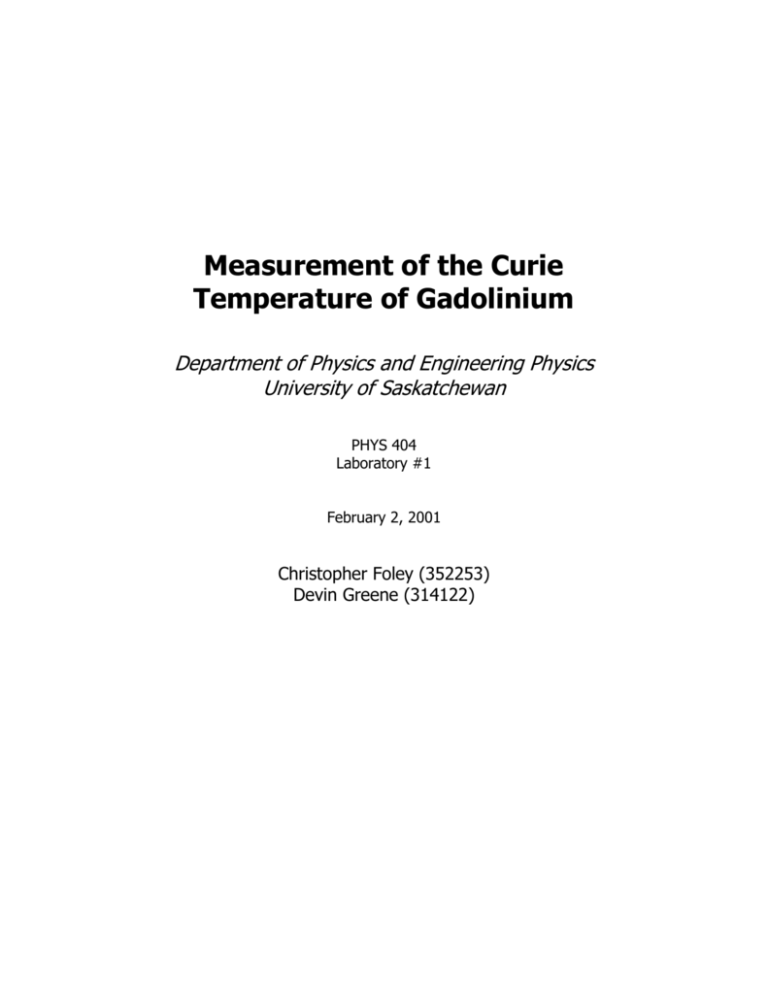
Measurement of the Curie Temperature of Gadolinium Department of Physics and Engineering Physics University of Saskatchewan PHYS 404 Laboratory #1 February 2, 2001 Christopher Foley (352253) Devin Greene (314122) Abstract This experiment was designed to measure the Curie temperature of gadolinium. A value of 287.12 +/- 0.62K was obtained, which does not fall within the range of accepted values of 293K – 289K. The experiment was performed twice, once in a water bath and once in an oil bath. Possible reasons for the low value of the Curie point include impurities in the sample, a defective inductance meter, and improper heating and cooling of the sample during the experiment. More research needs to be done on the improper heating and cooling methods, as there may be a relaxation time for the alignment of and creation of domains within a magnetic material. 1 Objective The objective of this experiment was to determine the Currie temperature of gadolinium. Theory Magnetic materials are magnetic because of the combined effects of individual magnetic dipole moments of atoms in the material. In ferromagnetic materials, the atoms tend to arrange themselves so that these dipoles are aligned. This only occurs on a small scale, however, localized to regions called domains. Normally in a macroscopic sample, these domains are randomly orientated, so that overall, the sample is non-magnetic (Figure 1). If the sample is placed in an external magnetic field, a torque is exerted on domains that are not aligned with the field, and the domains will rotate to align themselves with the field. If the external field is then removed, most of the domains will remain in an aligned state, so that overall the sample is now a permanent magnet (Figure 2). Figure 1 – Random Domains Figure 2 – Aligned Domains 2 At low temperatures, random thermal vibrations are not strong enough to dislodge this dipole alignment. Above a certain temperature called the Curie temperature or Curie point, however, the atoms now have enough thermal energy to overcome the binding between neighboring dipoles to break up the domains. Once the order of the domains is destroyed, the sample loses its magnetic properties: it is now paramagnetic. This is an abrupt process and occurs at a well-defined temperature for a particular material. It is called a phase transition, much like the transition from solid to liquid. Above the Curie temperature, the sample is paramagnetic and below the Curie temperature, it is ferromagnetic. The magnetic susceptibility of a ferromagnetic material at temperatures above the Curie temperature is given by the Curie-Weiss law: 1 C T Tc (1) where is the magnetic susceptibility of the sample, is the magnetic permeability of the sample, C is the Curie constant which depends on the material, T is the temperature of the sample, and Tc is the Curie temperature. An easy way to measure the permeability of a sample is to measure the inductance of an air-core solenoid, then place the sample in the solenoid, and measure how the inductance changes. If the inductance of the air-core coil is Lo and the inductance of the coil with the sample is L, then the permeability of the sample is given by: L Lo (2) where is a geometrical factor that depends on the shape of the coil. If equation (2) is now put into (1): 3 L y (T ) 1 Lo 1 T Tc C (3) it can now be seen that y(T) is a linear function of T with slope 1/C. This function crosses the temperature axis when T=Tc. Thus by changing the temperature of the sample and recording the inductance of the coil (at temperatures above the Curie point), the Curie temperature can be determined. Note that the values of C or need not be known. For plotting results, the assumption was made that =1. This is valid only for determining the Curie temperature, however, and not for measurement of the permeability. Apparatus This lab was performed by measuring the inductance of a sample of gadolinium as its temperature changed. The range over which the temperature was varied was designed to include the theoretical Curie point, around 18°C. The following components made up the test bench on which the experiment was performed: 6) 7) 8) 8) 1) 3) 5) 2) 4) Figure 3 Apparatus 4 1) Gadolinium sample (~.5cm x .5cm x1.5cm) 2) Water tank (half filled with water) 3) BX Precision 858 Universal LCR meter 4) 2.119 mH Inductive Coil 5) 250ml beaker (half filled light oil) 6) B. Braun Thermomix M D-3508 water circulator/heater 7) Barnant 90 600-7840 (type ‘K’ thermocouple) Digital Thermometer 8) Stand Temperature control is essential in this experiment. The temperature must change at a relatively slow rate to allow for thermal conduction lag in the water, the oil, and the sample. The heater was used to heat the sample, while snow was added to the water to cool the sample. Both temperature controls were used in discrete amounts to allow time for thermal conduction. The thermocouple provides a constant reading of the temperature around the sample. The LCR meter was used in inductance mode at a setting of 1kHz. Note that the oil bath is necessary to prevent oxidation of the gadolinium sample. Procedure Before the system above was constructed, the inductance of the empty coil was measured, as it is needed for analysis purposes. The system shown in Figure 3 was initially set to just above room temperature (as verified by the thermocouple) by using the Thermomix heater. Snow was then added to the water in small amounts to decrease the temperature from twenty-five degrees Celsius to eleven and a half degrees Celsius over a period of twenty-seven minutes. The Thermomix was running with its heater turned off to help mix the water as it cooled. The readings from the thermocouple and LCR meter were recorded every minute until room temperature was reached and all subsequent measurements were taken every thirty seconds. As the LCR meter and thermocouple 5 have auto-off features, the respective data holds were pressed before data was recorded (effectively avoiding shutdown) to ensure continuity in the data. Once eleven and a half degrees Celsius was reached, the Thermomix heater was turned on. Measurements were taken every thirty seconds as the water heated. At approximately eighteen degrees Celsius, measurements were taken every minute until a final temperature of twenty-three and a half degrees Celsius. Observations See tables on the following pages. 6 Trial 1 - Water Bath Cold -> Warm -> Cold Temperature Inductance Time of measurement (+/- 0.1C) (+/- 0.002 mH) (h:mm:ss) +/- 5s 10.9 5.701 0:00:00 11.5 5.699 0:01:00 12.2 5.696 0:02:00 12.9 5.691 0:03:00 13.6 5.684 0:04:00 14.0 5.674 0:05:00 14.4 5.663 0:06:00 14.9 5.651 0:07:00 15.3 5.637 0:08:00 15.5 5.630 0:08:30 15.6 5.623 0:09:00 15.9 5.616 0:09:30 16.0 5.609 0:10:00 16.2 5.601 0:10:30 16.2 5.594 0:11:00 16.6 5.586 0:11:30 16.8 5.577 0:12:00 17.0 5.568 0:12:30 17.2 5.559 0:13:00 17.4 5.550 0:13:30 17.6 5.540 0:14:00 17.6 5.530 0:14:30 18.0 5.520 0:15:00 18.3 5.509 0:15:30 18.4 5.498 0:16:00 18.8 5.486 0:16:30 19.0 5.473 0:17:00 19.2 5.459 0:17:30 19.4 5.444 0:18:00 19.6 5.429 0:18:30 19.8 5.412 0:19:00 20.0 5.395 0:19:30 20.2 5.376 0:20:00 20.4 5.336 0:21:00 20.8 5.294 0:22:00 21.2 5.249 0:23:00 21.2 5.202 0:24:00 21.7 5.155 0:25:00 22.1 5.106 0:26:00 22.5 5.053 0:27:00 22.8 5.001 0:28:00 23.2 4.948 0:29:00 23.4 4.897 0:30:00 23.8 4.847 0:31:00 24.3 4.796 0:32:00 24.8 4.747 0:33:00 25.2 4.698 0:34:00 25.5 4.655 0:35:00 Begin cooling here Temperature Inductance Time of measurement (+/- 0.1C) (+/- 0.002 mH) (h:mm:ss) +/- 5s 25.3 4.623 0:36:00 24.9 4.551 0:37:00 24.9 4.505 0:38:00 24.7 4.468 0:39:00 24.5 4.435 0:40:00 24.5 4.402 0:41:00 24.0 4.371 0:42:00 missed 0:43:00 23.9 4.316 0:44:00 23.5 4.290 0:45:00 missed 0:46:00 23.3 4.247 0:47:00 missed 0:48:00 23.1 4.201 0:49:00 22.5 4.183 0:50:00 22.2 4.164 0:51:00 22.2 4.152 0:52:00 21.9 4.139 0:53:00 20.8 4.127 0:54:00 20.8 4.126 0:55:00 20.1 4.127 0:56:00 20.2 4.131 0:57:00 19.7 4.137 0:58:00 19.4 4.147 0:59:00 19.3 4.154 1:00:00 19.1 4.164 1:01:00 18.7 4.176 1:02:00 18.5 4.188 1:03:00 18.1 4.200 1:04:00 17.7 4.213 1:05:00 17.5 4.227 1:06:00 17.6 4.241 1:07:00 17.3 4.254 1:08:00 17.1 4.269 1:09:00 17.0 4.282 1:10:00 16.6 4.296 1:11:00 16.5 4.308 1:12:00 16.4 4.323 1:13:00 15.9 4.336 1:14:00 15.6 4.350 1:15:00 15.3 4.364 1:16:00 15.2 4.377 1:17:00 14.7 4.390 1:18:00 14.0 4.407 1:19:00 13.9 4.417 1:20:00 13.7 4.430 1:21:00 13.3 4.443 1:22:00 13.1 4.455 1:23:00 12.3 4.481 1:24:00 7 Trial 2 - Oil Bath Warm -> Cold -> Warm Temperature Inductance Time of measurement Temperature Inductance Time of measurement (+/- 0.1C) (+/- 0.002 mH) (m:ss) (+/- 0.1C) (+/- 0.002 mH) (m:ss) 25.0 2.878 0:00:00 11.5 4.432 0:26:30 25.0 2.863 0:02:00 11.5 4.454 0:27:00 25.2 2.858 0:03:00 11.3 4.496 0:27:30 25.1 2.855 0:04:00 11.7 4.536 0:28:00 24.0 2.859 0:05:00 12.2 4.573 0:28:30 22.3 2.872 0:06:00 12.8 4.609 0:29:00 21.5 2.885 0:07:00 13.3 4.642 0:29:30 21.0 2.903 0:07:30 13.8 4.672 0:30:00 20.7 2.926 0:08:00 14.2 4.700 0:30:30 20.4 2.955 0:08:30 14.8 4.727 0:31:00 20.0 2.990 0:09:00 15.1 4.751 0:31:30 19.6 3.033 0:09:30 15.5 4.774 0:32:00 19.4 3.081 0:10:00 15.8 4.795 0:32:30 19.0 3.133 0:10:30 16.1 4.813 0:33:00 18.7 3.189 0:11:00 16.3 4.831 0:33:30 18.5 3.247 0:11:30 16.4 4.846 0:34:00 18.3 3.305 0:12:00 16.5 4.861 0:34:30 18.1 3.363 0:12:30 16.7 4.874 0:35:00 18.0 3.420 0:13:00 16.8 4.886 0:35:30 17.7 3.477 0:13:30 17.0 4.897 0:36:00 17.6 3.531 0:14:00 17.3 4.907 0:36:30 17.5 3.582 0:14:30 17.5 4.916 0:37:00 17.3 3.678 0:15:00 17.5 4.925 0:37:30 17.1 3.726 0:15:30 17.6 4.932 0:38:00 16.9 3.771 0:16:00 17.6 4.939 0:38:30 16.6 3.814 0:16:30 17.7 4.946 0:39:00 16.6 3.855 0:17:00 18.0 4.951 0:39:30 16.3 3.895 0:17:30 18.3 4.957 0:40:00 16.2 3.934 0:18:00 18.4 4.961 0:40:30 16.1 3.971 0:18:30 18.6 4.965 0:41:30 15.9 4.007 0:19:00 18.8 4.968 0:42:30 15.4 4.060 0:19:30 18.9 4.970 0:43:30 15.3 4.075 0:20:00 19.0 4.972 0:44:30 15.3 4.109 0:20:30 19.5 4.973 0:45:30 15.1 4.140 0:21:00 20.0 4.973 0:46:30 14.9 4.171 0:21:30 20.5 4.971 0:47:30 14.6 4.206 0:22:00 21.0 4.968 0:48:30 13.8 4.230 0:22:30 21.5 4.961 0:49:30 13.2 4.257 0:23:00 21.7 4.951 0:50:30 12.9 4.285 0:23:30 22.0 4.938 0:51:30 12.5 4.311 0:24:00 22.3 4.923 0:52:30 12.4 4.337 0:24:30 22.5 4.904 0:53:30 12.0 4.364 0:25:00 22.7 4.887 0:54:30 11.8 4.385 0:25:30 22.7 4.867 0:55:30 11.7 4.410 0:26:00 23.0 4.847 0:56:30 Begin warming here 23.3 4.827 0:57:30 23.5 4.806 0:58:30 8 Analysis Because of the large deviation from the accepted value and the large number of errors associated with it, the water trial data was not used in the analysis. Only the oil bath data is discussed here. To derive the Curie temperature for the sample of gadolinium the acquired data had to be massaged so it could be applied to the Curie-Weiss law. This involved choosing which data points to use, and thus how to fit the best curve to our data. Given the formula, as in (3) assuming a gamma factor of 1: L y (T ) 1 Lo 1 T Tc C (4) One could graph the dependence of 1/(L/Lo –1) against temperature. This provides a means to calculate the experimental Curie point through extrapolation. The method employed was to select a point that was central in the region that behaves according to the Curie-Weiss law. Then the first point at a higher temperature was used with the selected point to make a linear least squares fitted line. Where the line crossed the x-axis revealed the Curie temperature predicted by those two points. Then the same process was done with the first point below the selected point. Many subsequent fits were performed using the first n points above with the first n-1 points below, and then with the first n-1 points above and the first n points below. Making a histogram of the Curie temperature predicted by certain point combinations aided in locating the region that best seemed to obey the Curie-Weiss law. Once a point that was included above (or below) caused a significant change in the predicted value, the point previous was considered the cutoff point. The histogram has been included in the Appendix (Figure A1). The points that were include were four points below the median and three points above the median, 9 Plot 1: Curie Temperature 2.500 2.000 1/(L/Lo -1) 1.500 Curie Trend Linear (Curie Trend) y = 0.411x - 5.723 1.000 0.500 0.000 12.0 13.0 14.0 15.0 16.0 17.0 18.0 19.0 20.0 21.0 -0.500 Temperature [degrees C] 10 22.0 where the median was defined as the data point at 18.7 degrees Celsius. This point was chosen as it consists of a significant number of points (eight) and the inclusion of more points decreases the slope of the line. Error values for plotting the graphs were calculated using the derivative method. For a y-axis value given by: L y 1 Lo 1 (5) the error in the calculated value is: y y 2 L L 1 (6) Lo Lo Rearrange (5) to solve for and substitute back into (6) to get: y y y 1 L L 1 L Lo (7) Here L and Lo are taken to be the same value, 0.002mH. The error in the x-axis is that associated with the Digital Thermometer, thus it has been taken as the accuracy of the instrument: +/- 1 oC. This least squares fit line crosses the x-axis at 13.959 oC (287.119 K), which is the resulting experimental Curie temperature for gadolinium, as shown in Plot 1. The graph shows only the Currie-Weiss region; the full data graphs are presented in the Appendix (Figures A2 – A4) The confidence interval for this value can be derived as followed: ( t / 2 S 1 x n S xx , t / 2 S 1 x ) n S xx (8) where = 287.11K (13.959 oC) 11 t/2 = 2.306 (for 95% Confidence Interval) S= 0.024651 (square root of variance estimator) n=8 x(avg) = 291.1 oK Sxx = 2.44 This leads to a 95% confidence interval of (13.34, 14.58) oC, or (290.73, 289.49 K) for the experimental Curie temperature. Discussion Accepted values for the Curie temperature of gadolinium vary somewhat. Values range from 293.4K (CRC Handbook, 81st ed), 293K (Ashcroft and Mermin 1976, Wilkes 1973), 290K (von Ardenne 1973), 290.1K (Lewowski and Wozniak 1997) down to 289K (Kittel 1956, Legwold et al 1953, Flippen 1963). Trial 1 – Water Bath From the water bath trial, a Curie temperature of 272.7K was determined. This is much lower than the excepted value. There are a number of possible reasons for this. The first is that the sample was placed in a water bath. This should not have been done. Water contains dissolved oxygen, which will react with gadolinium. This oxidation process reduced the purity of the sample, which altered the Curie point. It is not known what magnitude or direction this impurity would change the Curie temperature. Because this was the first trial, the second trial results in the oil bath would also be affected. The second problem arose from the inductance meter. The meter had an automatic shut off if no buttons were used after a few minutes. When the meter was turned back on after one of these automatic shut offs, the inductance reading was drastically different. The amount of difference varied between 0.02mH and 2.0mH, and 12 the direction of the change appeared to be random as well. Sometimes it was a higher reading than before it shut off; sometimes it was lower. This same effect was not apparent when the meter was shut off manually. To avoid this effect, whenever a measurement was taken, the hold button on the meter was pushed so that it did not shut off automatically. While this means there are no large ‘jumps’ in the readings as they were taken, it does mean there could have been a large offset to the data. While the experiment was being set up, the meter was turned on and it shut itself off several times. An offset in the data would result in the curve being shifted up or down by a constant amount. The overall shape of the curve would not be changed, but the x-intercept of the best-fit line would, and hence the Curie temperature would change. The biggest problem, however, was the way in which the sample was heated and cooled. In the water bath, the first half of the cycle where the temperature started below the Curie point then heated had a very low Curie temperature, but the shape of the curve seemed reasonable. When the sample was cooled back down again, the curve was quite different than expected. During the warming phase, the inductance decreased as expected. Once the cooling cycle started, this trend in the inductance continued. It was only after over 20 minutes and approximately five degrees that the inductance started to increase again. Two hypotheses were suggested to explain this. The first was that there was a temperature gradient in the sample. Because there was no waiting time between the warming and cooling cycles, the sample didn’t have time to ‘catch up’ with the temperature of the surrounding water bath. The temperature reading did not correspond to the actual temperature of the bulk sample. This explanation has two major flaws. First, the thermocouple was in direct contact with the sample. Second, the sample was 13 relatively small, and should not take over 20 minutes to begin to come into equilibrium with the surrounding water bath The second hypothesis has to do with the individual domains in the sample, and the rate at which they are created or destroyed as the Curie temperature is crossed. As the sample was warmed above the Curie point, the domains in the sample were mostly destroyed by the thermal motion of the atoms. There is a drop in the inductance of the sample at the Curie point, but a general downward trend of the inductance continues as the sample is heated. This is because domains still exist and are being destroyed by random thermal motions. When the sample first cooled, the temperature was still above the Curie temperature. There was still enough thermal energy in the sample to continue to destroy domain arrangements. This is why the inductance reading still decreased although the temperature was now being lowered. There seems to be some kind of ‘relaxation time’ for the destruction of the domains in a sample to reach equilibrium with the sample temperature. If the sample had been left at the high temperature for some time and allowed to reach a steady inductance reading before it was cooled, better results would have been obtained. This same effect was also taking place before the experiment even started. The sample was being stored at room temperature before the experiment took place. It was then placed in the chilled water bath, and the experiment was started. It was roughly 10 minutes between the time the sample was in the water and the time the experiment was started. This would have a strong effect on the data because the sample was quickly brought across the Curie point, and then slowly warmed back up to cross it again. Overall, this argument seems reasonable on a qualitative basis. No data was found however to confirm or deny it. 14 Trial 2 –Oil Bath From the oil bath, a Curie temperature of 287.11 +/- 0.62K was obtained. While this value is closer to the accepted values than the result from the water bath, it is still not in agreement. The possible reasons for this are similar to the water bath trial. First, the purity of the sample was in question after the water bath trial. This would affect the Curie temperature. Second, the inductance meter still had its problems with the automatic shut off feature. Again, during the course of the experiment, the meter was not allowed to shut off between readings, but there still could be a large shift of the data due to the meter. Depending on the direction of the shift, the measured Curie temperature would be lower or higher than the actual value. Finally, the same problem with switching between cooling and heating phases occurred. This time, the sample was first cooled, and then warmed. As the temperature was decreased, the inductance measurement increased. Once the cooling stopped and the warming began, the inductance continued to increase. Much like the water bath trial, it was about 20 minutes and nine degrees before the inductance started to decrease. The temperature gradient explanation can be ignored for the same reasons as before. The ‘relaxation time’ explanation can still be used in this case. As the sample is cooled below the Curie point, domains begin to form between neighboring atoms. Most of this formation occurs at the Curie temperature, but some will occur after the Curie point has been reached. Once the sample started to be warmed up again, the temperature was still below the Curie point, so domains were still being formed in the sample, and the inductance measurement would still increase. If the sample had been allowed to come to 15 an equilibrium state where no new domains were being formed before being warmed up again, the data would have given results that are more accurate. Recommendations A few things could be done differently when the experiment is repeated. First, the sample should remain in oil whenever possible. This wasn’t obvious from the documentation for the lab. Secondly, the reliability of the inductance meter was in question. Perhaps a different meter could be used, or if there was a known sample to calibrate the meter from, data could be adjusted for any kind of offset it may introduce. Finally, further research into the ‘relaxation time’ for the domains to begin forming/destroying should be done. Because we came up with the hypothesis late in the lab, there was not enough time to do a thorough literary search. Until this hypothesis can be confirmed or reputed, it would be a good idea to leave the sample at a fixed temperature for a long time before beginning the experiment. If a cooling cycle is being performed, then the sample should be stored at a warm constant temperature (~25°C) for many hours, overnight if possible. Similarly, if a warming cycle is being performed, then the sample should be kept at a constant cold temperature (~12°C) for many hours before the experiment is started. Another idea that might make the transition at the Curie temperature more drastic would be to put the sample in the coil and run a current through the coil to saturate the susceptibility of the sample. Of course, this will only work if a warming cycle is being performed. This is one way to ensure that the sample is in a known state before the experiment begins. 16 References Griffiths, D.J. Introduction to Electrodynamics. 3nd edition, Reed College, 1999. Hook and Hall Solid State Physics. 2nd edition, John Wiley & Sons Ltd, England 1998. Johnson and Bhattacharyya, Statistics Principles and Methods. 3rd edition, John Wiley & Sons Inc, Toronto, 1996. Kraftmakher, Yaakov, “Curie point of ferromagnets”. IOP Publishing LTD & The European Physical Society, 1997. Lewowski and Wozniak, “Measurement of Curie temperature for gadolinium: a laboratory study for students”. IOP Publishing LTD & The European Physical Society, 1997. 17 Appendix 18 1u 1b 1b1u 2b1u 1b2u 2b2u 2b3u 3b2u 3b3u 4b3u 3b4u 4b4u 4b5u 5b4u 5b5u 5b6u 6b5u 6b6u 7b6u 6b7u 7b7u 7b8u 8b7u 8b8u 8b9u 9b8u 9b9u 10b8u 10b9u 11b8u 11b9u 12b8u 12b9u 13b8u 13b9u 14b8u 14b9u 15b8u 15b9u 16b8u 17b9u Curie Temperature (degrees Celsius) Figure A1 Finding the Curie-Weiss Range 15 14.5 14 13.5 13 12.5 12 11.5 Combination of points below and above the median 19 Figure A2 Oil Bath Warm to Cold Data Used for Analysis 3.500 3.000 1/(L/Lo - 1) 2.500 2.000 1.500 1.000 0.500 282.0 284.0 286.0 288.0 290.0 292.0 294.0 296.0 Temperature (K) 20 298.0 Figure A3 Oil Bath Cold to Warm Data Discarded 0.900 0.880 0.860 1/(L/Lo - 1) 0.840 0.820 0.800 0.780 0.760 0.740 0.720 284.0 286.0 288.0 290.0 292.0 294.0 296.0 Temperature (K) 21 Figure A4 Water Bath Cold to Warm Data Used for Analysis 0.850 0.800 1/(L/Lo - 1) 0.750 0.700 0.650 0.600 0.550 282.0 284.0 286.0 288.0 290.0 292.0 294.0 296.0 Temperature (K) 22 298.0 Figure A5 Water Bath Warm to Cold Data Discarded 1.100 1.050 1/(L/Lo - 1) 1.000 0.950 0.900 0.850 0.800 284.0 286.0 288.0 290.0 292.0 294.0 296.0 Temperature (K) 23 298.0
